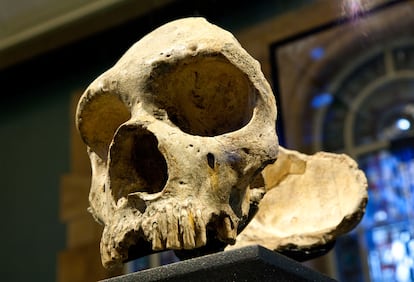Genetics explain the demise of the Neanderthals: They did not go extinct, we assimilated them
The clans of this human species were smaller than previously thought, and were eventually absorbed by sapiens, according to a new DNA study

In 2010, a Swedish geneticist, who had been obsessed in his youth with the idea of recovering genetic material from an Egyptian mummy, achieved a much greater milestone. That year Svante Pääbo revealed the first genome of a Neanderthal, the species closest to ours, and confirmed that tens of thousands of years ago we had sex and children with them. It was a true cataclysm in the history of human evolution, and its impact can be seen today in the majority of the planet’s inhabitants, who still carry a small percentage of Neanderthal DNA in each of their cells. In 2022, his lab colleagues threw Pääbo into a pond to celebrate him winning the Nobel Prize in Medicine for these discoveries.
The fact that today it is possible to extract and read DNA from fossils has provided data on how and where sexual encounters occurred between the Neanderthals — the human species originally from Europe — and us, Homo sapiens — who were originally from Africa. Until now, science has focused on how Neanderthal genes affected sapiens. For example, genes from the Neanderthals and Denisovans — another human species discovered by Pääbo — have allowed sapiens to live in the highest regions of the planet, and strengthened our immune system in the past, while making it more vulnerable to some of today’s diseases. The biggest enigma remains why, if we were so compatible, the Neanderthals disappeared 40,000 years ago and sapiens became the only human species on Earth.
On Thursday, a study has turned the focus around and asked how sapiens DNA affected Neanderthals, and if we somehow contributed to their disappearance. The results, published in the prestigious journal Science, reveal unknown chapters of this story.
“Our data support the idea that a factor in the extinction of Neanderthals, probably the most important, is that they were simply absorbed by sapiens,” Liming Li, a molecular biologist at Princeton University and first author of the study, tells EL PAÍS.
Researchers analyzed the only three Neanderthal genomes that are preserved: the DNA of an individual found in Vindija, Croatia, who lived about 52,000 years ago, of another found in Chagyrskaya, in the Altai Mountains of Siberia (Russia), from about 80,000 years ago, and a third Neanderthal from the Denisova Cave, also in the Altai, who lived about 120,000 years ago. They compared their genome with that of 2,000 modern sapiens to calculate how much genetic material was passed on to Neanderthals and when it happened.
The work confirms that the first and largest encounter between both species was much earlier than previously thought, about 200,000 years ago. Groups of Homo sapiens from Africa arrived in Europe and had sex and children with Neanderthals, who received up to 10% of their genome. It is a considerable amount, taking into account that current sapiens from outside Africa have only around 2% of Neanderthal DNA. What’s most interesting is that these groups of sapiens never managed to settle in Europe or Asia, and they became completely extinct.
About 120,000 years ago, another wave of sapiens ventured outside Africa, probably in search of game and new territories. The climate was favorable, and created a land bridge between Africa and the Sinai Peninsula, through which they reached the Near East and the Arabian Peninsula. On this occasion, the encounters must have been smaller, since the Neanderthals only received 0.5% of sapiens DNA. Nor did this wave of migrants stay in Europe, a continent where Neanderthals had been living for hundreds of thousands of years, despite the terrible ice ages.
In the final stages of this story, the gene flow took a turn, and it was the sapiens who began to receive important genetic contributions from Neanderthals. Between 60,000 and 50,000 years ago, sapiens took over up to 10% of the Neanderthal genome, and that percentage increased even further.
There is one last chilling fact: the percentage of sapiens DNA in the last Neanderthals, who lived about 40,000 years ago, is zero. By then they were the last human species to go extinct.
At this point, the work reveals an illuminating piece of information. The presence of sapiens DNA in the genome of Neanderthals has meant that the size of Neanderthal populations have been overestimated. The new calculation reveals that they were 26% smaller, less than 2,500 individuals distributed in small isolated tribes across all of Europe. Furthermore, they were plagued by inbreeding and under pressure from the arrival of the sapiens, who had larger, better connected clans, and weapons to kill from a distance.
“In the end, successive waves of sapiens immigration from Africa overwhelmed the Neanderthals until they were unable to remain a separate species and were finally assimilated by sapiens genetics,” says geneticist Joshua Akey, co-author of the study.
Akey adds: “From previous studies, we knew that there is much less Neanderthal presence on the X chromosome, which is associated with hybrid boys surviving less than girls. There are also indications that some Neanderthal genes were harmful and were purged from our genome. So it seems that there was a certain incompatibility in these crossings, but it must not have been very great, since it did not prevent sapiens from having Neanderthal ancestors and vice versa.”
Neanderthals disappeared forever, but thanks to the fact that both species assumed and cared for their mixed-race children, their genetics are still alive and actively contribute to many sapiens physiological functions, from rapid blood clotting to the tendency to suffer from some mental illnesses.
Geneticist Carles Lalueza-Fox was one of the first to talk about Neanderthal assimilation. The new study cites the Spanish researcher in describing how unidirectional gene flow caused the sapiens population to become bigger and more diverse when they interbred with Neanderthals, while the Neanderthal population became smaller and weaker. “Sometimes we think of the last Neanderthal as a solitary individual who cannot find a partner,” explains Lalueza-Fox. “I imagine him more like a person whose partner was a Homo sapiens.”
Sign up for our weekly newsletter to get more English-language news coverage from EL PAÍS USA Edition
Tu suscripción se está usando en otro dispositivo
¿Quieres añadir otro usuario a tu suscripción?
Si continúas leyendo en este dispositivo, no se podrá leer en el otro.
FlechaTu suscripción se está usando en otro dispositivo y solo puedes acceder a EL PAÍS desde un dispositivo a la vez.
Si quieres compartir tu cuenta, cambia tu suscripción a la modalidad Premium, así podrás añadir otro usuario. Cada uno accederá con su propia cuenta de email, lo que os permitirá personalizar vuestra experiencia en EL PAÍS.
¿Tienes una suscripción de empresa? Accede aquí para contratar más cuentas.
En el caso de no saber quién está usando tu cuenta, te recomendamos cambiar tu contraseña aquí.
Si decides continuar compartiendo tu cuenta, este mensaje se mostrará en tu dispositivo y en el de la otra persona que está usando tu cuenta de forma indefinida, afectando a tu experiencia de lectura. Puedes consultar aquí los términos y condiciones de la suscripción digital.
More information
Archived In
Últimas noticias
NASA discovers Titan doesn’t have an ocean, but a ‘slushy ice layer’ that increases possibility of life
Innocence lost in the forest of the child soldiers: ‘Each leader of the armed group had his girls’
‘Fallout’ or how the world’s largest company turned an anti-capitalist apocalyptic Western into a phenomenon
From inflation to defending migrants: Eileen Higgins and Zohran Mamdani inaugurate the new Democratic resistance against Trump
Most viewed
- ‘El Limones’ and the growing union disguise of Mexican organized crime
- Christian Louboutin: ‘Young people don’t want to be like their parents. And if their parents wear sneakers, they’re going to look for something else’
- The low-cost creative revolution: How technology is making art accessible to everyone
- ‘We are dying’: Cuba sinks into a health crisis amid medicine shortages and misdiagnosis
- Liset Menéndez de la Prida, neuroscientist: ‘It’s not normal to constantly seek pleasure; it’s important to be bored, to be calm’











































